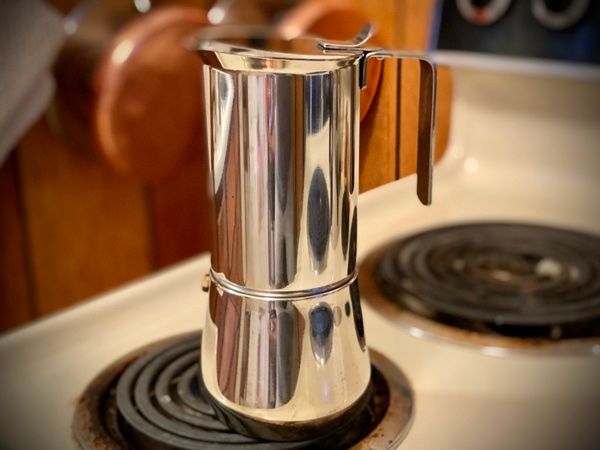Secrets of the moka pot.
How to make a perfect stovetop espresso.

The moka pot is essentially a percolator for espresso. But instead of the hot water dripping down through the grounds, it’s forced up through the grounds with pressure. This article explains why a moka pot really does make espresso and how to make a great cup of the stuff.
Alphonso Bialetti invented the moka pot in 1933 as as a way for Italians to make espresso at home. Today it’s estimated that 9 out of 10 households in Italy have a Bialetti Moka Express sitting on their stove. The other household? Today we have enless varieties of moka pots available that are based on this original concept, so maybe that have one of those.
Does a moka pot really make espresso?
Though the moka pot is accused of not making real espresso, it actually makes a more historically authentic espresso than today’s high-pressure machines. At the dawn of espresso, about 1900, the original machines generated about 2 bars of pressure, the same amount as a moka pot.
Probably the main reason moka pots are accused of not making a real espresso is that the original pressure is not enough to produce a crema. While your barista may use a machine that generates the cafe standard of 9 bars of pressure the moka pot can make an espresso anywhere, even over a campfire. And compared to standard k-cup “espresso”—well, there is no comparison.
The foolproof method for stovetop espresso.
Here’s how to make a consistently delicious stovetop espresso with the least amount of effort.
- Fill the bottom tank with filtered cold water to just under the safety valve.
- Hold the funnel over the sink and fill with Cafe Bustelo (yellow pack) coffee. Don’t pack it down. Level off with a knife.
- Carefully place the funnel filled with grounds into the tank so none spill.
- Screw the pot onto the tank firmly.
- Set on a medium heat until the coffee fills the pot.
- Serve.
I’m sure the moka-pot connoisseurs are screaming their heads off right now because this method breaks the rules and goes against their self-proven techniques. So after too much experimentation, here’s the overexplanation for how the above process was painstakingly arrived at.
- Filtered water has fewer impurities than tap and spring water and makes for a smoother cup. Excessive minerals and chemicals can leave deposits in the pot that mess up the function and taste bad. Fridge pitcher filters, like Brita, are fine since starting with cold water seems to bring out flavors better than pre-heating the water. Moka pots are designed to work with exact amounts of water. Underfilling can actutally result in a weaker cup of coffee. Filling over the valve can lead to too much pressure and cause the pot to explode (seriously).
- If you try to fill the funnel when it’s seated in the tank, you’ll likely get excess grounds around the edges that can leak out the pressure.
- As with water, moka pots are designed to work with a specific amount of coffee. Packing coffee in the filter or overfilling can keep pressure from building properly. Underfilling results in weak coffee.
- Why Cafe Bustelo? Their yellow pack is a higher-caffeine Robusta bean that gives you the bold flavor they love in Italy. The grind of Cafe Bustelo is a bit coarser than an true espresso grind, but finer than standard grind: exactly what’s needed for a moka pot. The true expresso grind is too fine and can seep through the pores, clog the filter, cause incorrect pressure, result in muddy coffee and leave deposits that taste rancid.
- Why not fresh ground? Even high-end home grinders can give you an inconsistent grind. The grounds that are too small can clog pores and burn. The grounds that are too large don’t give you the full flavor. The consistent grind of Cafe Bustelo is sometimes referred to as a Cafe Cuban grind and is so prevalent in America, you’ll commonly see moka pots referred to as Cuban coffee makers.
- Be careful not to spill any of the dry coffee grounds into the water or around the edges of the filter. The espresso can pick up a burned flavor if grounds get in the water and this can also keep the pot from sealing correctly if it spills at the edges of the filter.
- If there’s not a good seal, you won’t get good pressure and the coffee can cook too long and burn.
- Bialetti recommends just putting the pot on a medium heat and leaving it. This has worked well for 90 years and despite what you read, no one has really improved on that technique. At this temperature, brewing can take 20 minutes, but assures that the water pushed through the grounds is just below a boil. While boiling on high generates more pressure and speeds up the process, it can also burn the coffee and exaggerate the bitterness. If you want your espresso a bit stronger, remove from heat when the pot is half full and stick the whole thing in the sink in about an inch of cold water. This quickly ends the brewing process.
My take.
On grumbly mornings, equal parts sweetened moka-pot espresso, half-and-half and ice can be a real blessing. For a consistent cup, determine how much you want to brew and buy a moka pot sized for that amount. I’ve used the Ilsa Turbo Express 6 cup (pictured above) for 10 years and the original seal is still working fine. Other than the seal, it’s all metal and makes about 8 oz. of espresso with the above method.
More:
- Three ways to fake a crema with stovetop espresso
- Want the lowdown on brewing the perfect cup of Turkish coffee?
